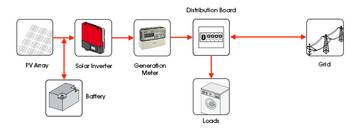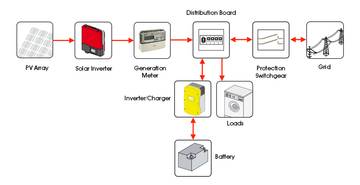Grid Connect System with Battery Storage
Adding Storage to Grid Connected PV Systems
A large portion of the energy generated by a typical PV system will be exported to the grid and there is increasing demand for solutions to enable better use of this energy through the use of energy storage.
Adding battery storage enables this excess generation to be stored for use later when consumption is higher than generation. As electricity prices rise this sort of battery storage system will become more and more cost effective. Some systems can also provide backup power in the event of grid failure.
We offer several Energy Storage Solutions to suit different budgets and requirements.
a) DC Coupled Energy Storage

- Here the battery is connected on the PV side of the solar inverter
- A high voltage battery (to match PV voltage) is used to store the energy when it’s generated for when it’s needed
- There is some (slight) reduction in the PV feed in tariff due to energy used in battery charge/discharge process
- No requirement to inform the DNO about changes to the system connected to the grid
- Not possible to charge the battery from cheap rate electricity
- Usually no operation in the event of a power cut


b) AC Coupled Energy Storage

- Here the battery is connected on the AC side of the solar inverter
- An additional battery inverter/charger is required to convert battery power to 230 Vac and vice versa
- There is no effect on the PV feed in tariff
- DNO approval needs to be obtained
- Possible to charge the battery from cheap rate electricity
- Back-up may be possible with additional switchgear


c) AC Coupled Energy Storage with Back-up

- Allows operation in event of a power cut
- Extra protection relays are required to enable AC loads to be run either from grid or from the battery and to provide a new neutral earth connection
- These can be included in inverter/charger
- Requires DNO approval
Not all installers are familiar with the issues and benefits of energy storage. We run regular training courses for installers on this topic and can provide recommendations:


Why implement grid backup?
- Get security for the future - from power cuts and rising energy bills
- Have the ability to use most or all of your generation - your energy costs less than importing grid energy
- Bask in the knowledge that you are your own power station
The system consists of:
- A solar inverter - to connect the solar photovoltaic (PV) panels.
- An inverter/charger - to convert battery power to 230V AC (grid power) and vice versa.
- Batteries - to store the energy when it’s generated, for use when it’s needed. Lead acid or lithium ion.
- Controls for monitoring and control of the system - to make a more efficient system and give you information on the distribution of energy.
- Cabling and switchgear - for efficient and safe operation
Typically a battery store of approximately 5kWh (~200 Ah 48VDC) usable storage might be required. Sealed lead acid batteries are a good choice for low maintenance and safe installation in a house. Lithium Ion batteries offer optimum performance and space savings.